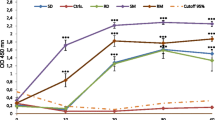Abstract
The passage of Trichobilharzia szidati schistosomula through the vertebrate lungs was examined in natural and abnormal hosts—birds (ducks Anas platyrhynchos f. domestica) and mammals (mice Mus musculus Bagg albino/c [BALB/c]), respectively. Using the methods of classical histology, the migratory route of worms was characterized, and the impact of migration on host tissues and the host cell reactions were evaluated. Living schistosomula were recorded in the lungs of ducks 2–10 days post infection (p.i.) and in the lungs of mice 2–4 days p.i. In ducks, the schistosomula migrated from the blood vessels through the blood capillaries to the lung tissue; then, they entered free air space of the lungs. The infection resulted in inflammatory reaction with nodules composed of infiltrated lymphocytes, heterophils, eosinophils and macrophages. These structures were formed around the blood vessels and in the gas-exchange tissues of the parabronchial walls and, consequently, in the walls of secondary bronchi. An extensive inflammation of secondary bronchi and parabronchi was observed. In the lungs of mice, the parasites were localized extravascularly in the alveolar walls. No migratory pattern similar to that in the lungs of ducks was recorded. No specific inflammatory reaction occurred. However, alveolar wall congestion, edema and lymphocyte infiltrates appeared and, therefore, pathogenicity of T. szidati was also confirmed in the murine host.





Similar content being viewed by others
Notes
The strain of T. ocellata used by Bourns et al. (1973) was isolated from L. stagnalis in Ontario, Canada. Haas and Pietsch (1991) used T. ocellata isolated from Höchstadt, Germany. The European T. ocellata corresponds with T. szidati Neuhaus, 1952, but the North American isolates are probably not identical with T. ocellata/T. szidati from Europe (Rudolfová et al. 2005).
References
Baysade-Dufour C, Martins C, Vuong PN (2001) Histopathologie pulmonaire d’un modele mammifere et dermatite cercarienne humaine. Med Mal Infect 31:713–722
Bayssade-Dufour C, Vuong PN, René M, Martin-Loehr C, Martins C (2002) Visceral lesions in mammals and birds exposed to agents of human cercarial dermatitis. Bull Soc Pathol Exot 95:229–237
Bourns TKR, Ellis JC, Rau ME (1973) Migration and development of Trichobilharzia ocellata (Trematoda: Schistosomatidae) in its duck hosts. Can J Zool 51:1021–1030
Haas W, Pietsch U (1991) Migration of Trichobilharzia ocellata schistosomula in the duck and in the abnormal murine host. Parasitol Res 77:642–644
Horák P, Kolářová L (2000) Survival of bird schistosomes in mammalian lungs. Int J Parasitol 30:65–68
Horák P, Kolářová L, Adema CM (2002) Biology of the schistosome genus Trichobilharzia. Adv Parasitol 52:155–233
Kouřilová P, Syrůček M, Kolářová L (2004) The severity of mouse pathologies caused by the bird schistosome Trichobilharzia regenti in relation to host immune status. Parasitol Res 93:8–16
Olivier L (1953) Observations on the migration of avian schistosomes in mammals previously unexposed to cercariae. J Parasitol 39(Suppl 3):237–243, 1953
Rudolfová J, Hampl V, Bayssade-Dufour C, Lockyer AE, Littlewood DTJ, Horák P (2005) Validity reassessment of Trichobilharzia species using Lymnaea stagnalis as the intermediate host. Parasitol Res 95:79–89, 2005
Souza Vidal MRF, Barbosa AA, Andrade ZA (1993) Experimental pulmonary schistosomiasis: Lack of morphological evidence of modulation in schistosomal pulmonary granulomas. Rev Inst Med Trop São Paulo 35:423–429
van Bolhuis GH, Rijks JM, Dorrestein GM, Rudolfova J, van Dijk M, Kuiken T (2004) Obliterative endophlebitis in mute swans (Cygnus olor) caused by Trichobilharzia sp. (Digenea: Schistosomatidae) infection. Vet Pathol 41:658–665, 2004
von Lichtenberg F (1987) Consequences of infections with schistosomes. In: Rollinson D, Simpson AJG (eds) The biology of schistosomes. From genes to latrines. Academic, London, England, pp 185–232
Wilson AR (1987) Cercariae to liver worms: development and migration in the mammalian host. In: Rollinson D, Simpson AJG (eds) The biology of schistosomes. From genes to latrines. Academic, London, England, pp 115–146
Acknowledgement
The authors thank Dr. František Čada for his help with interpretation of histopathology findings.
The work has been supported by the Czech Ministry of Education (MSM 0021620828 and MSM LC06009)
The authors declare that the all the experiments reported in present study comply with the current laws of Czech Republic and EU.
Author information
Authors and Affiliations
Corresponding author
Rights and permissions
About this article
Cite this article
Chanová, M., Vuong, S. & Horák, P. Trichobilharzia szidati: the lung phase of migration within avian and mammalian hosts. Parasitol Res 100, 1243–1247 (2007). https://doi.org/10.1007/s00436-006-0398-2
Received:
Accepted:
Published:
Issue Date:
DOI: https://doi.org/10.1007/s00436-006-0398-2




